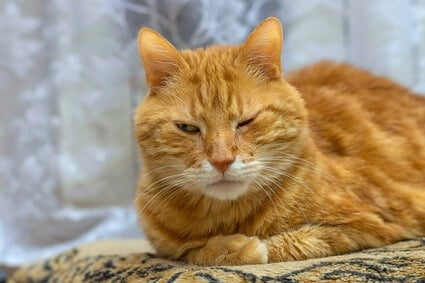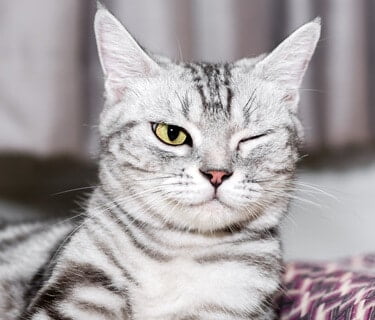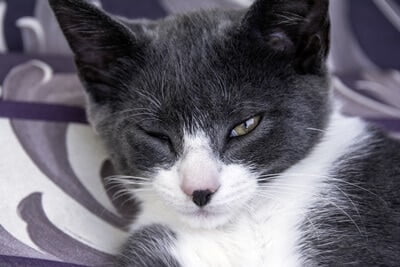Cat are born hunters that usually have wide open, alert eyes. The only exception to this rule is when your cat is dozing. A cat that keeps one eye shut all the time implies that something is causing discomfort.
A cat may keep one eye closed due to temporary irritation. If your cat is keeping its eye closed, then it has an infection. A red, itchy eye suggests conjunctivitis (pink eye.) If your cat’s eye is swollen, it may have glaucoma. Look at your cat’s iris, as it may have an ulcer or cataract.
Cats have very expressive eyes. A happy, healthy cat will have matching eye sizes. A cat with an eye problem will scratch and paw at its eye regularly. Consequently, you will notice redness around the eye.
My Cat Can’t Open One Eye Properly
Failure to open one eye properly or squinting is linked to:
- Eye infections
- Conjunctivitis
- Glaucoma
- Ulcers on the cornea
- Cataracts
- Blepharitis
- Foreign objects trapped in the eye
In addition to the eyelid, take a closer look at your cat’s pupils. According to the Archives of Neurology and Psychiatry, mismatched pupils denote a condition called anisocoria.
Look out for discoloration of the iris. This often stems from a condition called melanosis. Melanosis is most common in older cats and is usually harmless. It will manifest as brown spots that resemble liver spots.

Types of Eye Infections in Cats
Feline eye infections are bacterial and can be treated with prescription medication. Signs that your cat has an eye infection include:
- Redness in and around the eye
- Excessive tear production
- Constant blinking or winking
- Protrusion of the eyeball
The majority of eye infections will be treated with prescription antibacterial eye drops. Never use human eye drops.
The prognosis for eye drops is good. Most cats make a full recovery in a short space of time. Do not allow the infection to run its course, as this will only aggravate the issue.
Conjunctivitis (Pink Eye)
Your cat’s eye will become inflamed, red, and swollen. This will be painful, so your cat will rub and claw at its eye.
According to the Journal of the American Veterinary Medical Association, conjunctivitis can affect both eyes. The cause could be due to allergies, or another cat may have infected your cat.
Feline conjunctivitis is treated with anti-inflammatory eye drops. Most cats will make a full recovery within 2 days of treatment.
Glaucoma
Glaucoma can occur when a cat’s eye infection is not treated. A cat must drain fluid through its tear ducts. If your cat is unable to do so, pressure builds up. This leaves your cat in pain and unable to open its eye.
Glaucoma must be treated at the first sign of symptoms. If glaucoma is left untreated, it may lose an eye. The signs of this condition include:
- Visible swelling in the eye
- Clawing and pawing at the eye
- Dilation of the pupils
- Thin, watery discharge
- Cloudy, discolored iris
Veterinary Pathology explains that uveitis, a form of inflammation, is the most common cause of feline glaucoma.
Glaucoma cannot be cured or reversed. The condition must be managed for the duration of a cat’s life. This is achieved through steroidal eye drops. Timolol and dorzolamide reduce the swelling and manage pain.
Corneal Ulcers
Cats can develop ulcers on the cornea. This occurs when layers of the cornea are depleted. Common symptoms of corneal ulcers include:
- Excessive ocular discharge
- A clear film over the eye
- Sensitivity to light, causing the cat to close one eye in a bright room
Ulcers can be caused by trauma or infection. Treatment will begin with antibiotic eye drops and pain management.
If the ulcer is deep, surgery may be required to remove it. If the ulcer is at the surface level, a vet can remove it with a swab.
Cataracts
Cataracts occur in senior cats as a natural part of the aging process. A cataract will resemble a cloudy blockage in a cat’s eye. Cataracts prevent light from entering the retina. This reduces a cat’s eyesight, eventually leading to blindness.
Your cat can survive with cataracts. Your cat will use its other senses to detect the surroundings. Cataracts can be removed surgically.
Blepharitis
Blepharitis is the scientific name for chronic inflammation of the eyelid. The issue will begin with irritation, which may come from a trapped foreign object or insect bite.
Your cat’s eyelid will become dry, flaky, and may start to leak pus. In addition, a cat’s eyelid will swell significantly. This will eventually leave the cat unable to open its eye.
Treatment for blepharitis is usually performed at home. Soak a cotton pad in warm water and hold it next to the cat’s eye for 15 minutes. If you repeat this daily, the swelling will start to calm down.
You may still need to treat the underlying cause of your cat’s blepharitis. Your cat may have developed an eye infection through the initial irritation. This will typically require antibiotic eye drops.
Removing Foreign Objects from a Cat’s Eye
Trapped foreign objects are common as cats don’t blink often. Signs that a cat has something trapped in its eye include:
- Pawing at the eye
- Rubbing its face on the floor
- Squinting
- Excessive tear production
Tangible items that could be become trapped in a cat’s eye include:
- Stones
- Dust and grit
- Ingrowing hair or fur
If your cat has a foreign object in its eye, remove it through washing. Mix a combination of warm water and saline solution. Never attempt to remove the object with tweezers. Cats are skittish about their eyes. Your cat will fidget, which can lead to injury.
Cat eyes can also be irritated by environmental elements. Dust, air freshener, and cigarette smoke can provoke a reaction. As before, wash your cat’s eye, and the irritation should pass quickly.
My Cat’s Eyes are Red Around the Edges
Red-ringed eyes in cats are not normal. Your cat may have experienced minor ocular trauma, such as being poked in the eye. Your cat may have walked into a branch or scratched itself while grooming.
If the trauma is mild, it will correct itself relatively quickly. Your cat will otherwise act normally and blink a little more. Within 1-2 hours, the redness will start to calm down.
If this is not the case, your cat likely has an eye infection or conjunctivitis. Redness of the eye is the first warning sign.
My Cat Blinks One Eye More Than the Other
Cats do blink, but they do so infrequently. You may never notice your cat blinking. This, in itself, is not a cause for concern. You may notice your cat blinking one eye, though. This could be because your cat is:
- Expressing affection
- Dealing with a foreign object trapped in its eye
A slow cat blink is a demonstration of affection. Many people call this a “cat kiss.” If your cat blinks one eye at speed, it likely has an irritation, and the blinking is an attempt to remove it.
Why Does My Cat Sleep with One Eye Open?
As naturally cautious animals, cats feel vulnerable while they sleep. Your cat may appear to sleep with one eye open. This is not the case. Cats have a transparent third eyelid, known as the nictating membrane. This is located in the corner of your cat’s eye, resting below the conjunctiva.
This eyelid closes while your cat is sleeping. This helps your cat doze while remaining alert to potential danger. If your cat catches sight of movement, it can quickly react.
Your cat may not be sleeping. Experimental Neurology explains that the eyelids of a sleeping cat will twitch, implying that it has entered REM sleep.

Can I Prevent Eye Problems in Cats?
It’s not always possible to prevent a cat from developing eye problems. Sometimes these concerns are genetic, or they develop issues associated with age and lifestyle.
Keeping a cat indoors may reduce exposure to eye hazards. Your cat will not encounter other pets and will avoid conflict. A lack of fighting clearly reduces the risk of infection or eye trauma.
Your cat should undergo an annual eye examination to identify any issues at an early stage.
Cat Breeds Most Prone to Eye Problems
The breed of your cat may contribute to eye issues. As the Australian Veterinary Journal explains, brachycephalic cats are more prone to ocular problems. These breeds include:
- British Shorthair
- Burmilla
- Exotic Shorthair
- Himalayan
- Munchkin
- Persian
- Scottish Fold
- Selkirk Rex
Brachycephalic cats have a unique skull shape. They have shorter, rounder heads. Their folds of skin can trap foreign objects. In addition, tears do not easily flow from the eyes of these cats, leading to the eyes drying out and inflammation.

